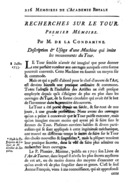It is curious that two 18th century writers on the lathe, Plumier and La Condamine, were better known as explorers.

"Recherches sur le Tour." (1734)
Charles Marie de la Condamine (1701-1774) published a two-part essay, "Recherches sur le Tour" in the Histoire de l'Académie Royale des Sciences for 1734. (Paris: l'Imprimerie Royale, 1736). The first part ("Premier Mémoire") was "Description et Usage d'une Machine qui imite les Mouvements du Tour." It appeared on pp. 216-258 with seven additional plates. (These are page images 365-507 and 408-421 of the BnF PDF.) The second part ("Second Mémoire") was "Examen de la nature des Courbes qui peuvent se tracer par les mouvements du Tour." It appeared on pp. 295-340 with six additional plates. (These are page image 468-503 and 504-514 of the BnF PDF.) This volume of the Histoire de l'Académie Royale des Sciences has been digitized by the Bibliothèque Nationale de France. and is available online in the Gallica Bibliothèque Numéque: http://gallica.bnf.fr/ark:/12148/bpt6k3531x/f364.pdf. It may be reproduced subject to the condition that its origin be identified, as it has been here. The icon at left links to a local copy of this BnF PDF.
To the best of my knowledge La Condamine's essays on turning have never been translated into English. They are, however, discussed at length in F. N. Zagorskii's Ocherki po Istorii Metallorezhushchikh Stankov do Serediny XIX Veka. (Moscow and Leningrad: Akademiya Nauk SSSR Publishers, 1960), which has been translated into English as An Outline of the History of Metal Cutting Machines to the Middle of the 19th Century . (New Dehli, India: Amerind Publishing Co. Pvt. Ltd., 1982.)
My understanding, based primarily on Zagorskii's analysis, is that while la Condamine understood practical turning, he was primarily a theoretician interested in describing the applied geometry of complex turning. In particular, he presents a device which, from a post-computer perspective, would seem to be best described as a rose lathe simulator. It could (according to Zagorskii) be used both to generate known rosettes for a lathe and to analyze the patterns which a given rosette could create.
Condamine's "rose engine simulator" appears also on Plate 58 of the plates "Tourneur et Tour a Figure" in Book 9 of the plates of the Diderot/d'Alembert Encyclopédie .
The digitial edition of this volume of the Histoire de l'Académie royale reproduced and extracted from here is owned by the Gallica Bibliothèque Numéque of the Bibliothèque Nationale de France. Its reproduction for noncommercial purposes is permitted by its licensing terms subject to the requirement that its origin is indicated (as has been done here). It is not subject to the same Creative Commons licensing terms as the rest of this page.
All portions of this document not noted otherwise are Copyright © 2012 by David M. MacMillan and Rollande Krandall.
Circuitous Root is a Registered Trademark of David M. MacMillan and Rollande Krandall.
This work is licensed under the Creative Commons "Attribution - ShareAlike" license. See http://creativecommons.org/licenses/by-sa/3.0/ for its terms.
Presented originally by Circuitous Root®
Select Resolution: 0 [other resolutions temporarily disabled due to lack of disk space]